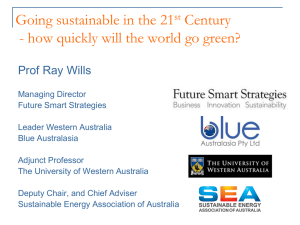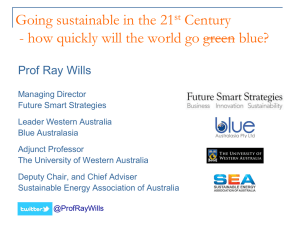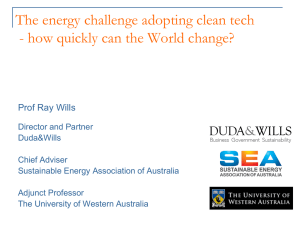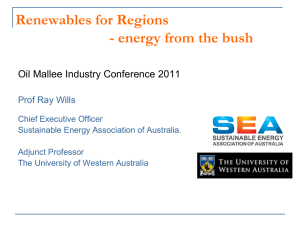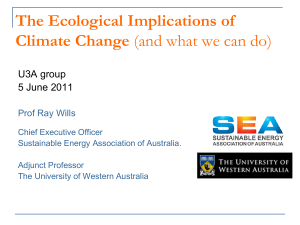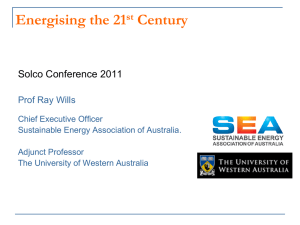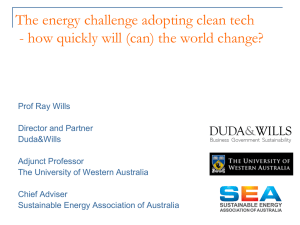Wills-adoptingcleantech-v3
advertisement
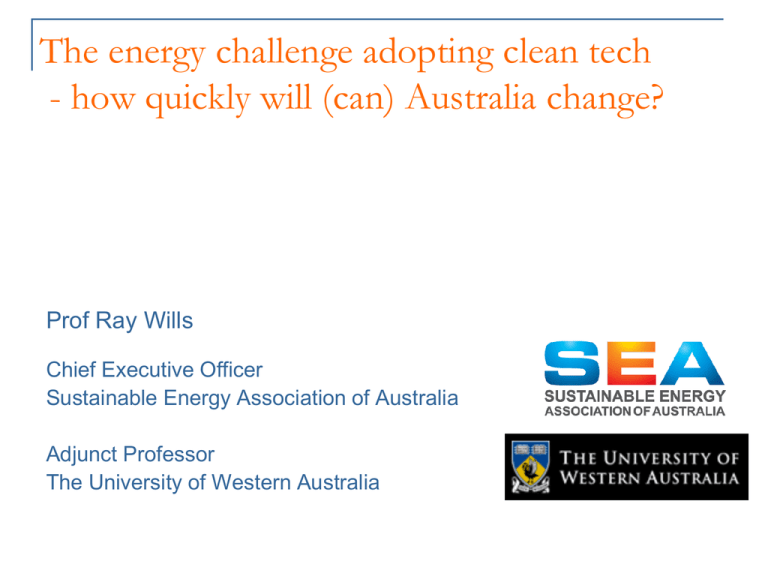
The energy challenge adopting clean tech - how quickly will (can) Australia change? Prof Ray Wills Chief Executive Officer Sustainable Energy Association of Australia Adjunct Professor The University of Western Australia Adoption of technology The natural turnover and retirement of appliances, buildings and vehicles can bring about a modest penetration of sustainable energy into Australia by 2021. However, adoption of sustainable energy will not be natural, with more rapid transitions favoured by: policy measures and regulation; consumer sentiment; pricing advantage. Global renewables 2008, 2009, 2010, 2011… World invests on average around 300-400 billion pa on energy projects of any type – conventional and renewables. 2008 - world invested more in total on renewable energy ($155 billion) than on traditional energy ($140 billion). Almost 50% of new generation built in 2009 was renewable energy - 80 GW of renewable power capacity built compared to 83 GW of fossil fuel plants. 2010 up 32% with $211 billion investment in 2010. $260 billion in 2011, up 5% on 2010 - 5 times 2004 2008 IEA forecast build for coal globally was 64 gigawatts actual build in 2010 was 14 GW (build of solar in 2010 was 17 GW)! Global renewables 2008, 2009, 2010, 2011… 36% surge in total investment in solar to $136.6 billion double the $74.9 billion investment in wind power in 2011. The scale of investment in solar is even more remarkable considering price of PV modules fell about 50% in 2011. The third-largest sector for investment in 2011 after solar and wind was energy-smart technologies, including smart grid, power storage, efficiency and advanced transport with total investment of $19.2 billion. While China has dominated investment in the last few years, USA investment surged past China in 2011 - USA was $56 billion in 2011, up 33%; China’s 2011 investment of just over $47.4 billion was marginally up from 2010. Global renewables Renewable energy growth Data IEA Building cities - China Guangzhou 13 million Changsha 7 million Chengdu 7 million Building cities – Chongqing, China Building cities - Korea Seoul Incheon Busan Australian renewables 2011… The transformation of Australia’s energy mix has begun – in 2011 36% of new investment in gas and 41% in wind. Coal-fired power generation, which currently accounts for around 75% of Australia’s total electricity generation, was only 17% of the committed new investment in power stations for the 12 months to October 2011. This is still behind the average world-wide investment in renewable energy – China’s economy 8 times larger than Australia, investment in renewables 50 times larger! (Australian investment less $0.7 billion in 2011 versus China investment $49 billion – to match China action, Australia would need to invest $6 billion per annum) Roger’s diffusion curve Technology adoption rates – US Will electric cars be dishwashers or VCRs? (Will there ever be any more dishwashers??) NY Times Technology adoption rates Zoepf 2011 Technology adoption rates Zoepf 2011 Technology adoption rates Zoepf 2011 Technology adoption rates 5 year product development cycle is appropriate for modeling the automotive industry – US NHTSA, 2010 BITRE (Aus) work argues slower uptake of 15 years. Spread of the technology to 90 % of vehicle fleet takes another 15 years. (Also – data not tracked for unsuccessful technologies – and competing technologies might be better) Doesn’t consider resistance to change by fossils! Technology adoption rates Zoepf 2011 Technology adoption rates Marked decrease in developmental lag Innovation/development of new products Supply side capabilities Market competition Growing consumer expectations Higher level of communication between consumers - blogspace Fleet/building/operations managers – and CFOs Regulation Energy security Trends in car prices and CO2 2002-2010 How clean are Europe’s cars? Technology adoption rates Zoepf - future automotive features could be reasonably expected to follow a similar pattern - small-scale deployment for approximately five years - exponential growth and an inflection point ten or more years after first application Can historic deployment rates be used to describe future technologies? We should expect some similarities! Is there an opportunity for disruptive technology entry? Beginnings of disruptive innovation may be in market innovations, Vehicle ownership model (eg Better Place) could rapidly change the how and what is purchased Roof top solar – companies may own the panels on your roof Rapid change - Personal mobility Private transport Fuel efficiency, other energy sources Transport Energy storage key New technologies may be disruptive Commercial vehicles Smith Newton electric truck Mega electric diesel hybrids London Bus Haul Pak + Earthmover Mitsubishi Fuso Honda prime mover Oshkosh Military Vehicle Electric mass transit Siemens Bordeaux light rail Bombardier wireless light rail Slim Ride -15 passengers Series 700 Shinkansen train – 285 km/h Flying and floating fuels February 25, 2008 – Virgin Atlantic Stages the First Biofuel Flight October 30, 2007 - U.S.A.F. Tests New Synthetic Fuel on Plane February 14, 2011 – Qantas follows US Military to algae biofuels September 13, 2011 – US Navy announces by 2016 Green Strike Group, powered by renewable diesel-electric engines, nuclear power and aviation biofuels, is able to operate independent of fossil fuel supply line threat or disruption Smart grids, smart houses (and farms) Integrated energy planning Smart grids to coordinate the actions of devices such as loads & generators Green cities Global Australia Tianjin Eco-City China Ulsan Ecocity Korea Masdar City UAE City of Sydney – 70% CO2 reduction by 2030 City of Melbourne Stirling City Centre, Perth City of Fremantle Yanchep – 2 x 100 000 Local government critical Industry chamber for any businesses / enterprise in sustainable energy or being more sustainable Based in Perth, almost 400 members nationally Information, communication, and networking businesses Government advocacy (lobbying) Policy development Legislation, regs and taxation - barriers and incentives Education, skills and training Calls for government leadership - and procurement Industry mapping Energising Kids – energy for the next generation Available for download from www.seaaus.com.au www.seaaus.com.au
